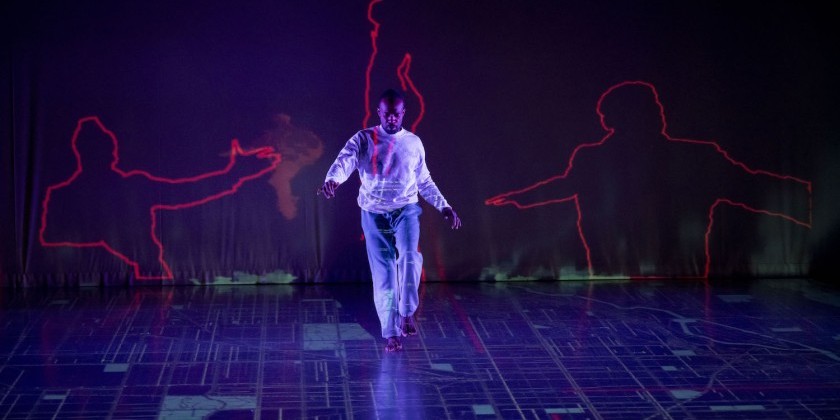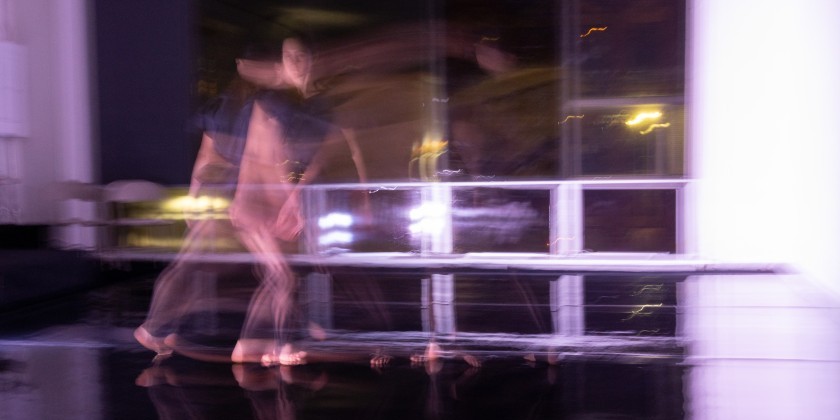IMPRESSIONS: "THAT SHOW" presented in Collaboration with Index Space

Kayla White and Taylor Schmuelgen Have Their Ears to the Ground
Producers: Kayla White and Taylor Schmuelgen
Creatives: Caroline Alter, Hillary Bonhomme, Campbell Ives, Johnny Mathews III, Uila Marx, Rae Su, Murphy Severtson, Natalia Sanchez, Stephanie Shin, Sheer Spectacle, DJ Peet the Scholar
Performers: Manatsu Aminaga, Caroline Alter, Hillary Bonhomme, Denise Chan, Campbell Ives, Dahyun Kim, Maya Lam, Johnny Mathews III, Uila Marx, Lily Mello, Destiny Nguyen, Kali Petrizzo, Murphy Severtson, Stephanie Shin, Rae Su, Karla Sandoval
On September 21, THAT SHOW hosted its second half-performance, half-celebration event. Held once again at Index Space, the production exuded a familiar, earnest DIY vibe — the kind that says, “We know how important this is, so we’re doing it ourselves.”
“This" refers to a curated presentation of emerging artists, for whom sustainable presenting models are hard to come by. Throughout the city, a slew of sign-up — dare I say “pay-to-play" — showcases offer artists a stage, a few light cues, and (hopefully) a recording, giving those who might not otherwise have these opportunities a chance to perform. Application and production fees are often involved.
THAT SHOW is different. Producers Kayla White and Taylor Schmuelgen (both 26) are dedicated to providing their presented artists with financial compensation, a rehearsal space stipend and list of affordable rentals in the city, robust social media marketing, and an undeniably warm, supportive environment. Performers do apply, but there’s no fee, and both of THAT SHOW’s productions so far have demonstrated a notably diverse curatorial approach.
Before the performance, I had the opportunity to chat with Peet the Scholar, resident DJ of THAT SHOW’s built-in after parties. They also presented work in April’s production. “THAT SHOW’s success is indicative of two people [White and Schmuelgen] who have their ears to the ground, who are actually in the emerging artist community,” Peet shared. “And their curation style is rooted in TLC: tender loving care. I’ve also noticed that since April, other showcases have started having DJs. I’m not saying we started it, but…” But they kind of did. They started something.

Shortly after our conversation, performances began. Caroline Alter and Campbell Ives opened with “Fuck It, Bop It,” a warm, tongue-in-cheek meditation on relationship dynamics. A couple in real life, the two performers were joined by a Bop-It (the 90’s toy) as a third relational entity. They played the game, invited the audience to play the game, and became sort of possessed by the game’s instructions.
Together, their movements evoked a clear and deep connection that became particularly striking when they were at opposite ends of the space. They were entirely in sync even when they could not see each other, both in unison and polyphony. Tonally, the work was serious and playful, as in, the play was very serious — not unlike being in love. A voiceover provided some sound relationship advice: “If you have 70-80% good and 20-30% shit, that’s pretty good. You have to find a 20-30% shit you can live with.”
“knots,” a vocal performance by Hillary Bonhomme, was an honest demonstration of creative decision-making. After setting up, she waited to see if the sirens outside would stop. They didn’t, and she began layering anyway. Using a loop pedal, she built a complex system of rhythmic breathing and harmonies. I watched Bonhomme vacillate between two states of creativity: making and observing. It was a fascinating contrast to an evening of mostly dance, which performers experience within their own bodies, independently from the audience. We listened along with Bonhomme while she built the distinct sounds of “knots” that evening — a generous sort of creative intimacy.

The stage was cleared of musical equipment and quickly reset with a table, chairs, a cake, and a bottle of wine. “it was the best of times it was the worst of times” created by Natalia Sanchez and performed by Manatsu Aminaga, Denise Chan, and Karla Sandoval began with a burst of activity, where each of the three performers took to a task: cutting the cake, distributing the plates, dutifully putting another dancer’s hair in a ponytail.
The dance unfolded to reveal a range of emotional extremes, slightly restrained: joy, anger, confusion, wonder. I wasn’t sure what the relationship among the dancers was, but it was clearly rich and layered. The work’s contemporary dance choreography featured virtuosic athleticism periodically interrupted by bursts of whimsy, which provided a sort of facade for the tension and care brewing underneath. At the very last second, a dancer’s face was smashed into the cake — a readily anticipated mess punctuating an otherwise tidy work.
As the room buzzed with transition chatter, a deliberate and focused Rae Su began asking individual audience members to create shapes with bubbles: a lion, a mermaid, an ocean, the sun. Sometimes unsatisfied with the results, he was nonetheless polite, ending each interaction with a high-pitched, “thank you, bye!” He possessed a determination and childlike audacity by insisting that these complex bubble shapes were achievable.
Soon, they were joined by Uila Marx who engaged them in a ferocious game of tag, unhindered by the relatively small performance space, and a vigorously whimsical duet with easeful, natural, and trusting partnering. The work, entitled “Re-member the Mystery,” conjured a charged partnership which posed important questions about adulthood and joy. Though Su and Marx were performing childlike play, their adult-self smiles would peek through, especially when they made eye contact.
When Su went limp and Marx was relentless in their efforts to revive him, the memory of those real smiles became quite sad. The work concluded with the pair rhythmically walking away and pulling each other back in, with the sound repeating, “power to the people, do we have power?”

After a lively, conversational intermission, Stephanie Shin’s “Go Bananas” swiftly recaptured our attention. Four dancers (Dahyun Kim, Maya Lam, Destiny Nguyen and Shin) in lime green and denim commanded the space in a jam-packed dance that never stopped moving. Guided in part by Charli XCX’s “Baby,” the performers were linked by their precise musicality. Awareness and connection buzzed underneath a sense of aloofness expressed through a distinct combination of contemporary dance and vogue.
Following this vivacious work was an equally captivating but altogether different solo entitled “I feel like I should make art about this.” by Murphy Severtson. With an accordion that felt like an additional limb, Severtson moved slowly with the tension of someone who lives in between self-assuredness and self-doubt. A voiceover revealed selected inner thoughts: “I’m very normal;” “I haven’t played the accordion in several months;” “I’ve got this thing coming up that’s gonna change my life;” “Do you guys think I’m good at this?” When they stretched the accordion as far as it could go and it sloughed off of their shoulders like a jacket, it felt at once like loss, longing, and liberation. The work was a stunning meditation on what happens when movement and music merge within one performer.
The mood remained serious for “I built a Castillo” by Johnny Mathews III. He emerged upstage left with an immediately serious tone underscored by Chaplin-esque costuming and physicality. Gong or bell sounds filled the room as he moved deliberately, his tall, lanky frame commanding the space with purposeful walking and direct beckoning gestures. A sphere in their mouth partly obscured their face—a curious and idiosyncratic feature.
As Mathews removed the sphere, their physicality lightened, though they retained an emotionally fraught weight and intentionality. His swirling, large movements filled the space, yet he stayed in proximity to the sphere, nearly kicking it but never making contact. The program note revealed: “I never met my maternal grandfather. My idea of him haunts me.” The precarious closeness to the object mirrored the haunting absence of a figure never known but deeply felt.

Sheer Spectacle's “The Space Between Lips,” performed by Lily Mello and Kali Petrizzo, was a study in power dynamics and intimacy illustrated in part by light and shadow. With flashlights (the only lighting for the work) and chairs, the performers spotlighted one another in moments of exposure and vulnerability. Mello, in a dark suit and dress shoes, lip-synced to “Nice Mover” by Gina x Performance: “I’m your transformer, call me Marlene, call me Gino, that’s me you know,” spotlighted against the back wall. Petrizzo, in a striking blue dress and stilettos, sauntered in the darkness downstage, as if she knew something that Mello did not.
When the beams of the flashlights accidentally grazed the disco ball suspended center stage (THAT SHOW’s symbol) the room filled briefly with fragmented light. Mello and Petrizzo's agency over the visibility of their work suggested that something vital remained just out of reach, a secret only hinted at. Their kiss at the end of the work, with the flashlights braced between their bodies, closed the gap between their tethered energies — a satisfying release of palpable tension.
This tension lingered, but was broken by applause and followed shortly by celebratory dancing. The audience joined the performers on the dance floor to mingle and freestyle together. “The thing about DJ-ing for the dance community,” Peet shared with me, “is that they’re always ready to dance.”
THAT SHOW returns to Index Space on December 14.














